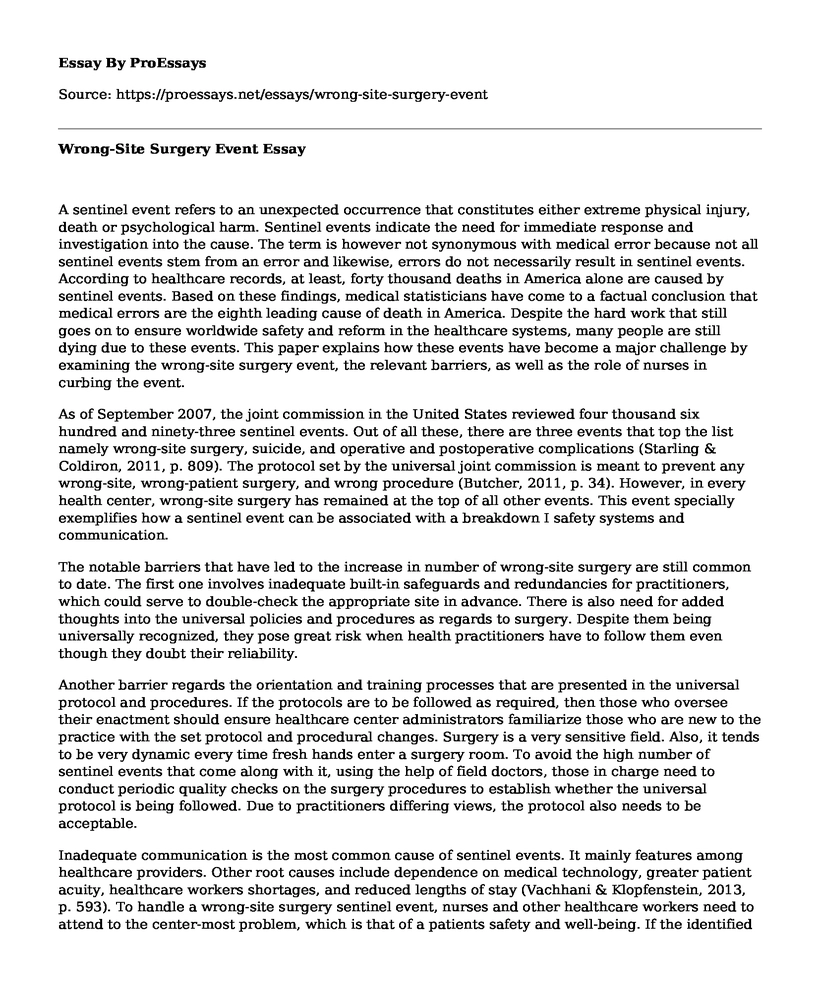A sentinel event refers to an unexpected occurrence that constitutes either extreme physical injury, death or psychological harm. Sentinel events indicate the need for immediate response and investigation into the cause. The term is however not synonymous with medical error because not all sentinel events stem from an error and likewise, errors do not necessarily result in sentinel events. According to healthcare records, at least, forty thousand deaths in America alone are caused by sentinel events. Based on these findings, medical statisticians have come to a factual conclusion that medical errors are the eighth leading cause of death in America. Despite the hard work that still goes on to ensure worldwide safety and reform in the healthcare systems, many people are still dying due to these events. This paper explains how these events have become a major challenge by examining the wrong-site surgery event, the relevant barriers, as well as the role of nurses in curbing the event.
As of September 2007, the joint commission in the United States reviewed four thousand six hundred and ninety-three sentinel events. Out of all these, there are three events that top the list namely wrong-site surgery, suicide, and operative and postoperative complications (Starling & Coldiron, 2011, p. 809). The protocol set by the universal joint commission is meant to prevent any wrong-site, wrong-patient surgery, and wrong procedure (Butcher, 2011, p. 34). However, in every health center, wrong-site surgery has remained at the top of all other events. This event specially exemplifies how a sentinel event can be associated with a breakdown I safety systems and communication.
The notable barriers that have led to the increase in number of wrong-site surgery are still common to date. The first one involves inadequate built-in safeguards and redundancies for practitioners, which could serve to double-check the appropriate site in advance. There is also need for added thoughts into the universal policies and procedures as regards to surgery. Despite them being universally recognized, they pose great risk when health practitioners have to follow them even though they doubt their reliability.
Another barrier regards the orientation and training processes that are presented in the universal protocol and procedures. If the protocols are to be followed as required, then those who oversee their enactment should ensure healthcare center administrators familiarize those who are new to the practice with the set protocol and procedural changes. Surgery is a very sensitive field. Also, it tends to be very dynamic every time fresh hands enter a surgery room. To avoid the high number of sentinel events that come along with it, using the help of field doctors, those in charge need to conduct periodic quality checks on the surgery procedures to establish whether the universal protocol is being followed. Due to practitioners differing views, the protocol also needs to be acceptable.
Inadequate communication is the most common cause of sentinel events. It mainly features among healthcare providers. Other root causes include dependence on medical technology, greater patient acuity, healthcare workers shortages, and reduced lengths of stay (Vachhani & Klopfenstein, 2013, p. 593). To handle a wrong-site surgery sentinel event, nurses and other healthcare workers need to attend to the center-most problem, which is that of a patients safety and well-being. If the identified event involves medical equipment, then the item must be taken out of service as soon as possible and labeled for investigation. The event must then be addressed up the leadership hierarchy and a consequent occurrence report presented as required by a centers policies. Each and every person that is involved in the event should participate in the cause analysis since each member might have unique insights and observations.
A sentinel event does not necessarily hurt the patient if he or she survives. It becomes a communal problem once it happens. Therefore, the earlier the cause of an event such as wrong-site surgery is identified, the better.
References
Butcher, L. (2011). Wrong-site surgery. Hosp Health Netw, 85(11), 34-37.
Starling, J., & Coldiron, B. M. (2011). Outcome of 6 years of protocol use for preventing wrong site office surgery. Journal of the American Academy of Dermatology, 65(4), 807-810.
Vachhani, J. A., & Klopfenstein, J. D. (2013). Incidence of neurosurgical wrong-site surgery before and after implementation of the universal protocol.Neurosurgery, 72(4), 590-595.
Cite this page
Wrong-Site Surgery Event. (2021, Mar 09). Retrieved from https://proessays.net/essays/wrong-site-surgery-event
If you are the original author of this essay and no longer wish to have it published on the ProEssays website, please click below to request its removal:
- Nursing Case Study Discussion Board
- Climate Change Causing Drought and How This Impacts Regional Young Australians 18-35 Paper Example
- Research Paper on Euthanasia: An Ethical Issue that Divides Societies
- Creating a DNP Project: A Guide for Nursing Professionals - Essay Sample
- Essay on Youths' Increase in Hookah Smoking: Early Exposure & Mythical Beliefs
- Nurses' Perspectives on Bed Enclosure - Free Article Review
- Essay Example on Loss for Words







